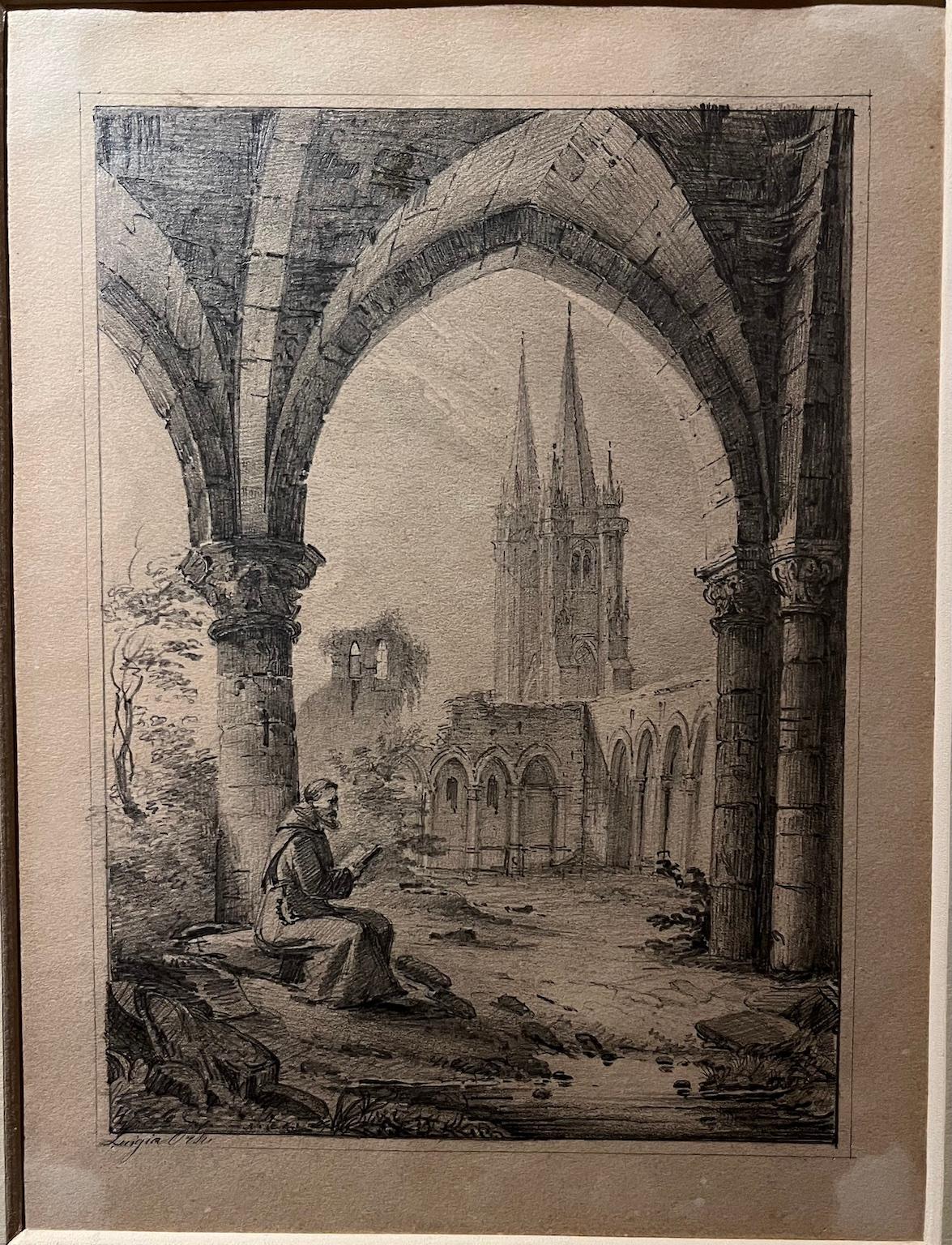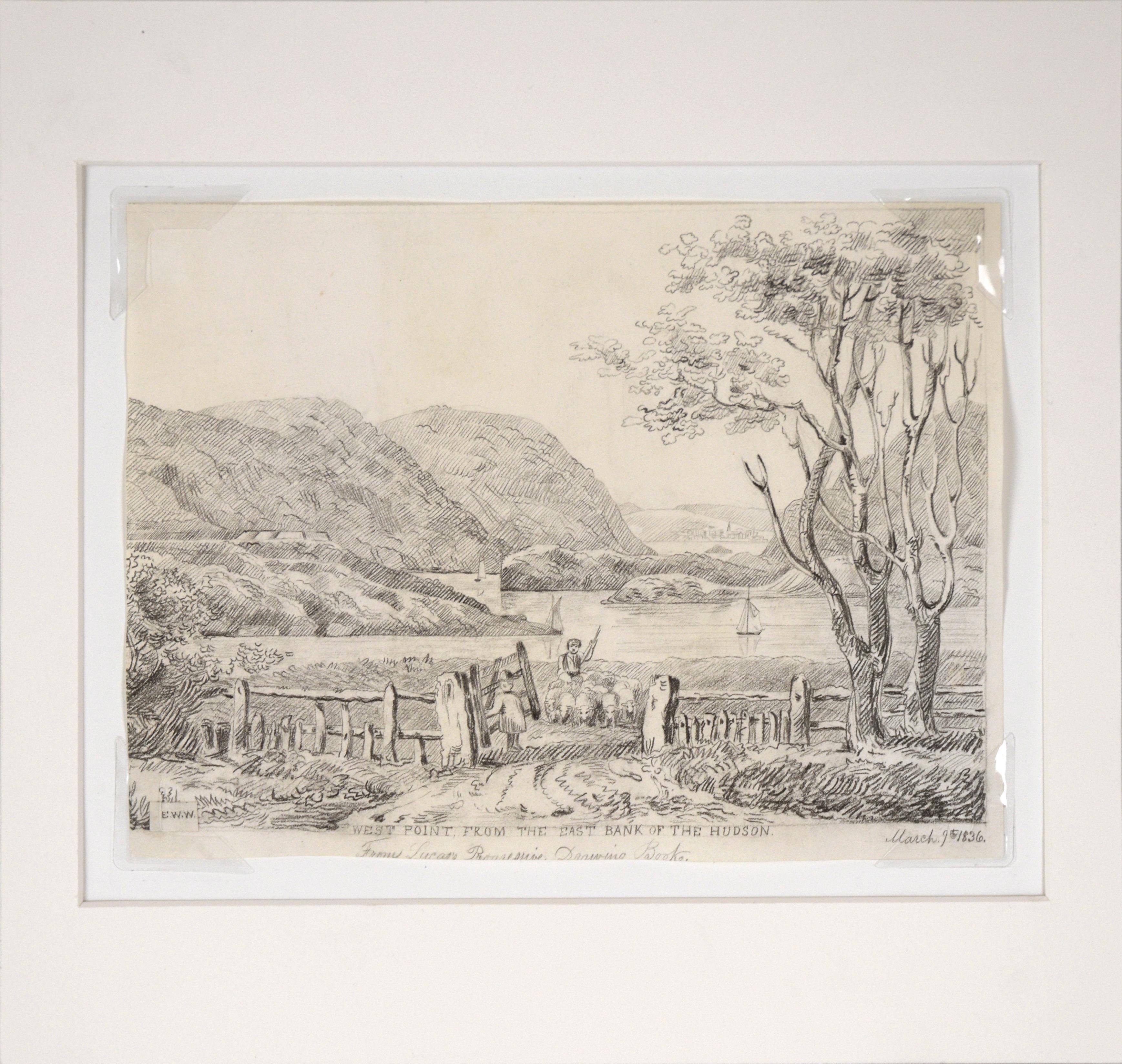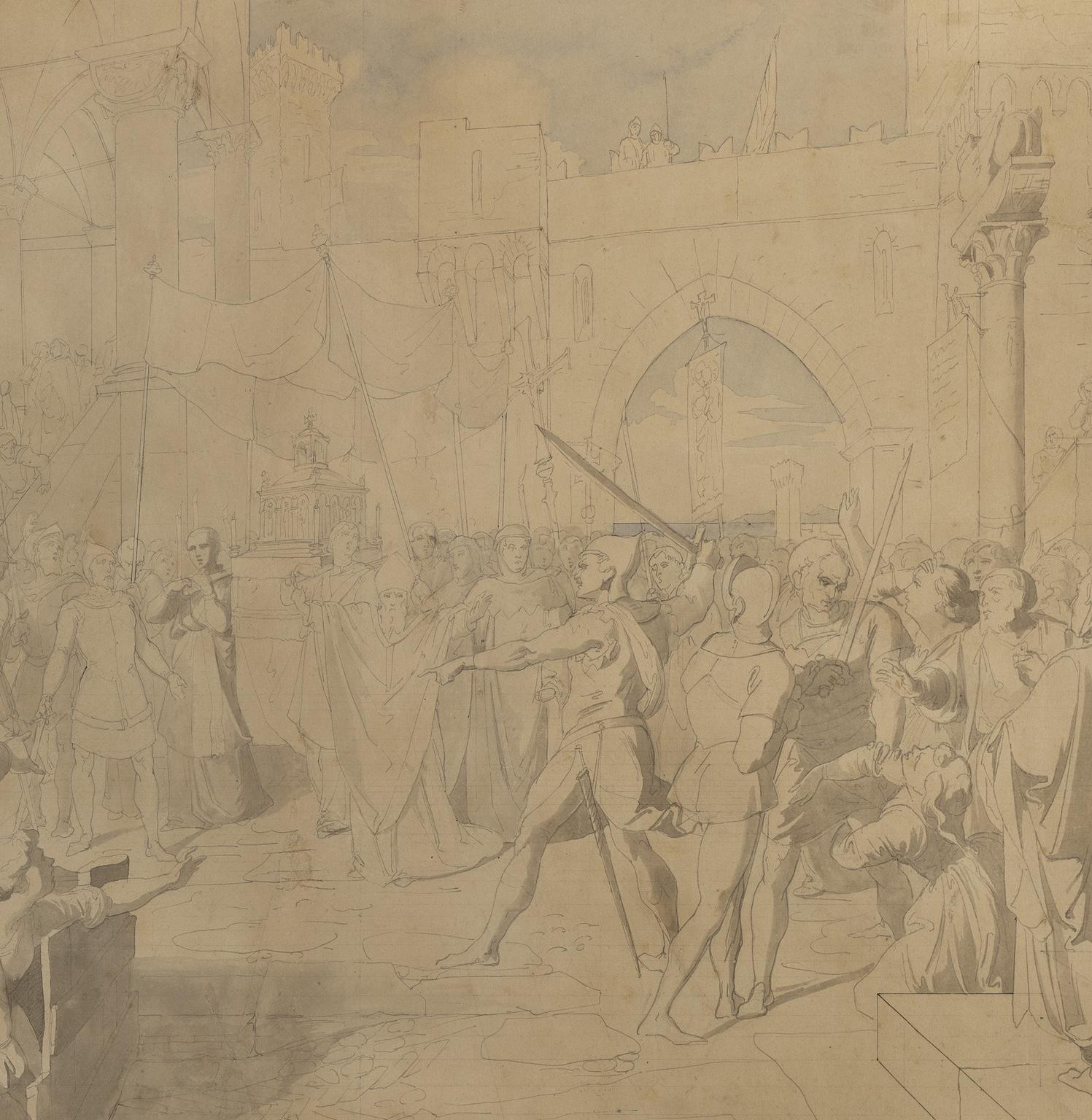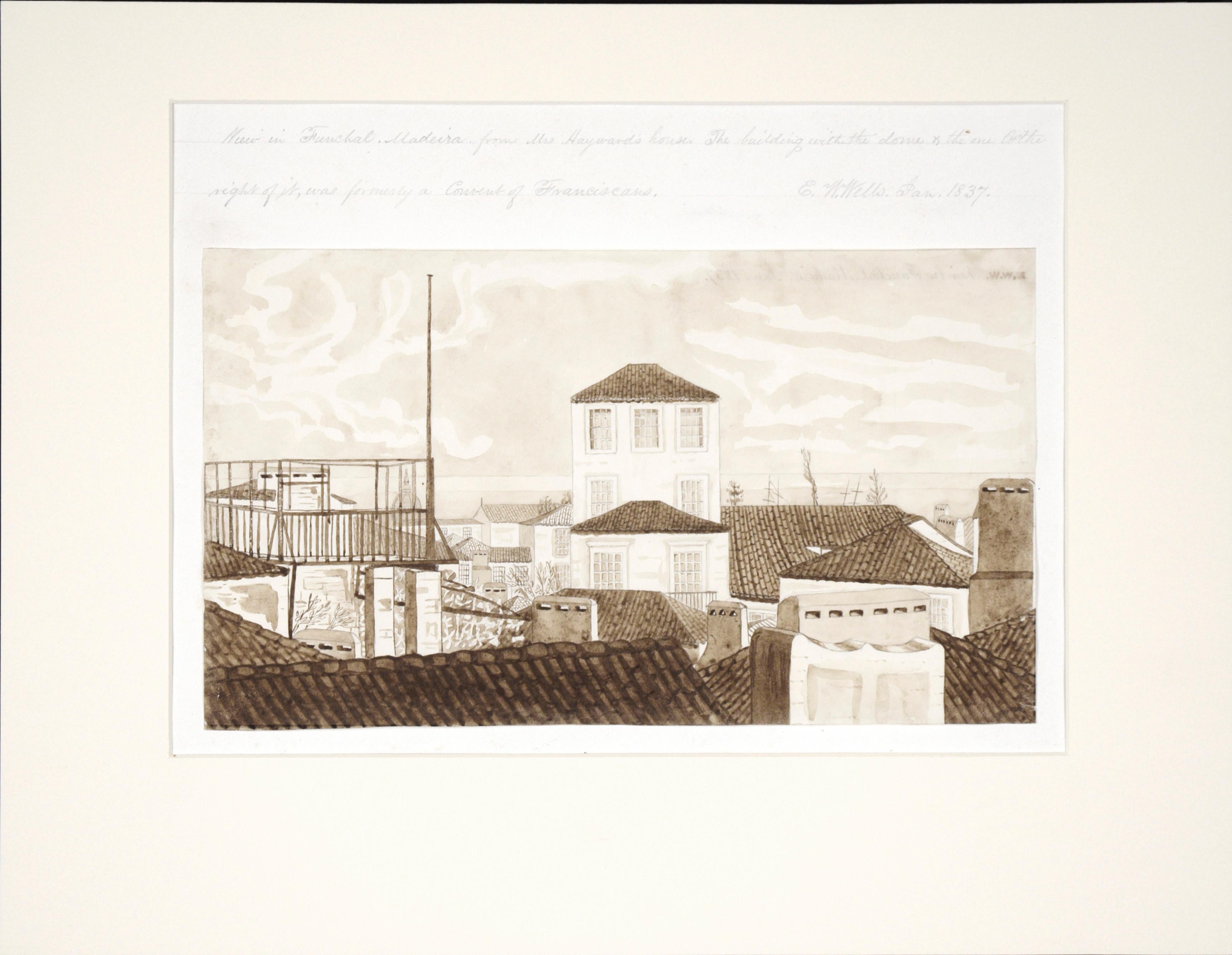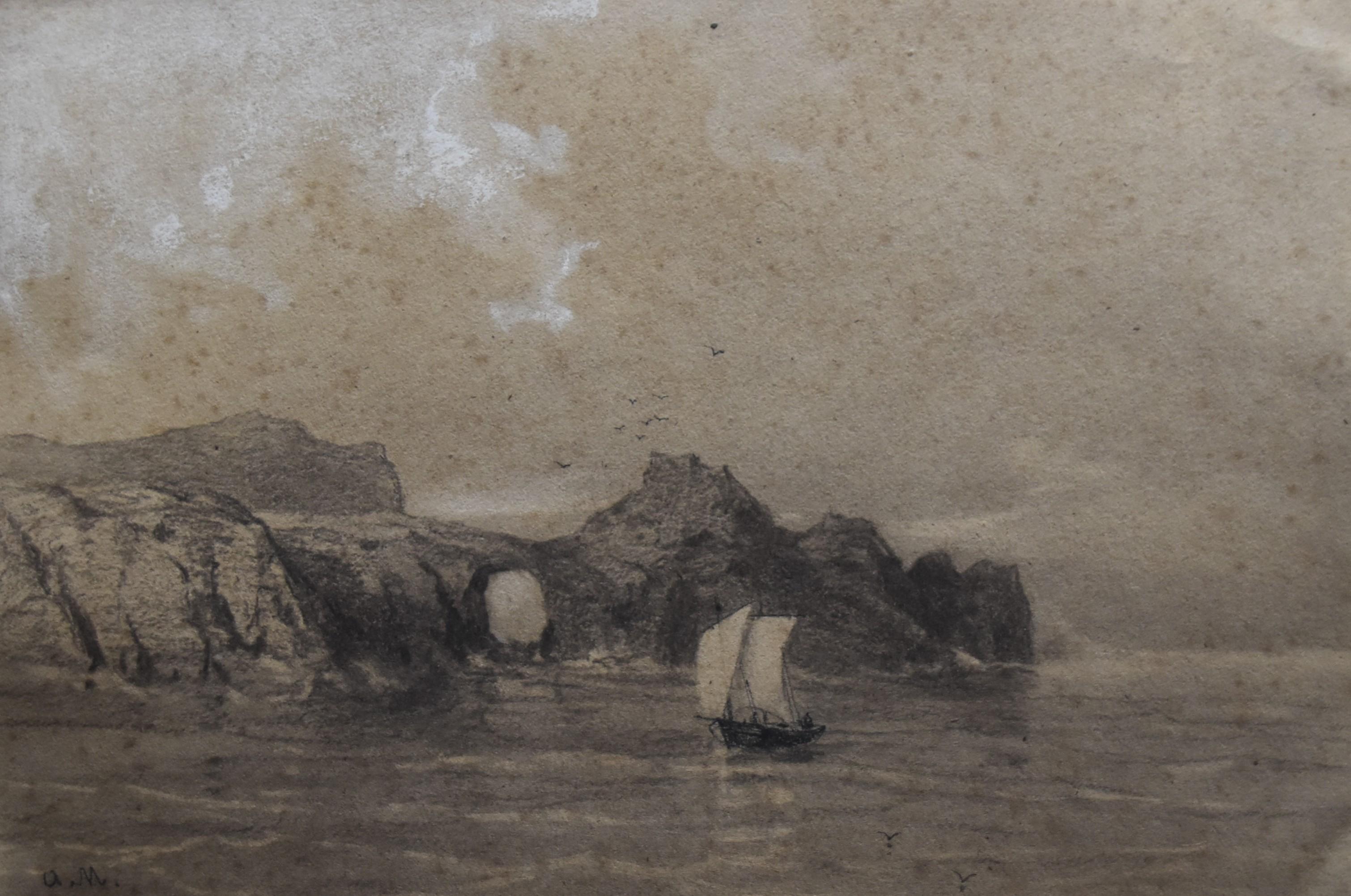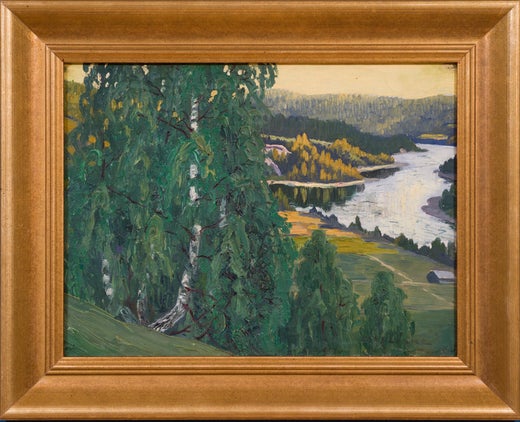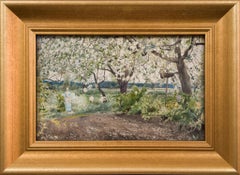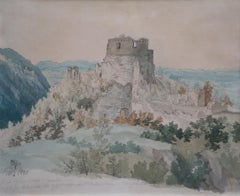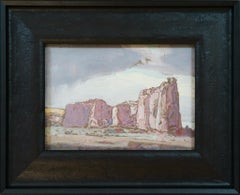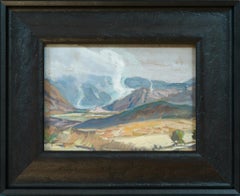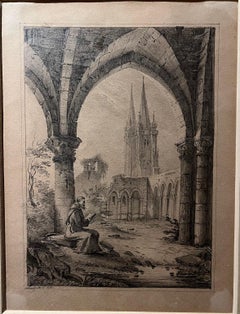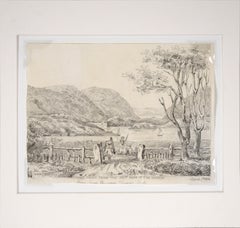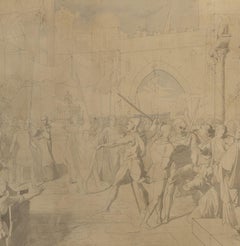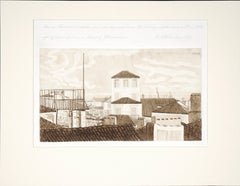Objekte ähnlich wie Evening Calm by the Northern River
Möchten Sie mehr Bilder oder Videos?
Zusätzliche Bilder oder Videos von dem*der Anbieter*in anfordern
1 von 9
Oscar LyckeEvening Calm by the Northern Riverc. 1910
c. 1910
Angaben zum Objekt
ink on paper
signed OSC. LYCKE
unframed 24 x 34 cm (9.4 x 13.4 in)
framed 33.5 x 43.5 cm (13.2 x 17.1 in)
Provenance:
Acquired directly from Katarina Gunnarsson, who inherited the painting from her mother, Barbro, the daughter of the artist.
Essay:
This ink landscape by Oscar Lycke (c. 1910) evokes the tranquil beauty of a remote northern valley. Bold black lines sweep across the paper to define a still river winding between gently rolling hills. In the foreground a humble log cabin nestles at the water’s edge, framed by slender birch and fir trees. Above, the sky is hinted at with strokes and washes of ink, suggesting a soft, diffused light. Although rendered simply, the scene feels remarkably three‑dimensional: darkly inked foreground shapes push forward against lighter, more delicate strokes in the distance. The effect is one of quiet serenity – the kind of calm encounter with nature that Lycke loved to capture. Lycke often painted and drew the Indalsälven valley in northern Sweden, especially around the village of Liden, and this image likely reflects that region. The gently undulating ridges and the placid river here closely resemble the Liden landscape he returned to again and again. One can almost imagine the shadowy woods and glassy water of Bodacke in Liden at dusk. This setting – an unspoiled Nordic river valley – was a recurring motif in Lycke’s work. He was deeply attached to the Swedish north; his art consistently celebrates its expansive forests, mirrored lakes, and rustic farmsteads.
Technique and Style
Lycke’s mastery of ink is evident in every expressive stroke. Using only black ink on paper, he achieves a rich range of tone and texture. Thick, confident strokes suggest the solidity of the cabin walls and tree trunks, while thinner, more rapid lines imply the finer details of foliage and rippling water. Some areas are left nearly blank – washes of pale ink indicate sky and distant hills – creating bright highlights that contrast with the deep blacks. The result is a dynamic interplay of light and shadow. Lycke applies the ink with a kind of lyrical energy: lines sometimes curl and dance, giving life to the scene, yet everywhere they remain under control, defining form with precision. This balance of spontaneity and discipline reflects his self-taught background. Without formal academic training, Lycke developed a personal technique that feels at once free and deliberate. The drawing’s expressive lines and compositional skill speak to his innate draftsmanship. Even in monochrome, he captures the “Nordic light” – the cool glow of a long summer evening – using subtle gradations of gray and sharp silhouettes against the sky. The overall effect is both bold and atmospheric, demonstrating Lycke’s confidence in handling ink as his medium.
Education and International Success
Lycke’s artistic journey was unconventional. Born in Sundsvall in 1877, he never attended a formal art academy. A childhood gift for drawing grew into a lifelong passion, and as a young man he moved to Stockholm to try making art his livelihood. He spent those early years studying nature directly and producing illustrations for magazines – a practical way to hone his skill. Around the turn of the century he even traveled to North America on art-study trips, broadening his perspective far from Sweden. Despite humble beginnings (and one discouraging schoolmaster), Lycke persevered. Over time he exhibited widely across Sweden – from Gothenburg to the north – and gradually gained recognition. His most remarkable success came abroad. In the 1910s Lycke brought his northern landscapes to New York, and American audiences were captivated. Contemporary accounts report that his exhibition in New York was a sensation: every painting he showed there sold quickly. The clear, romantic portrayal of Swedish wilderness and the masterful technique behind each canvas and drawing resonated with collectors and critics. In this way, Lycke achieved international acclaim, even while remaining relatively humble at home. By the time of his later shows – in Stockholm and back in Sundsvall – he was celebrated as a leading interpreter of Sweden’s natural beauty. Throughout his career, Lycke’s work remained rooted in the Swedish countryside. He captured all seasons of the north – from snowy winter nights to the midnight sun of summer – but always with the same reverence for nature. In Evening Calm by the Northern River, we see that devotion distilled into a simple ink study.
- Schöpfer*in:Oscar Lycke (1877 - 1927, Schwedisch)
- Entstehungsjahr:c. 1910
- Maße:Höhe: 24 cm (9,45 in)Breite: 34 cm (13,39 in)
- Medium:
- Bewegung und Stil:
- Zeitalter:
- Zustand:Very good condition. age related patina. A new black frame with UV protected art glass is included.
- Galeriestandort:Stockholm, SE
- Referenznummer:1stDibs: LU1445216379802
Oscar Lycke war ein schwedischer Maler, der für seine stimmungsvollen Darstellungen der nordischen Landschaft bekannt ist. Der 1877 in Sundsvall geborene Künstler widmete sein Leben dem Festhalten der Wälder, Flüsse und des Lichts von Norrland in Werken, die nationale Romantik mit einem starken Sinn für Realismus verbinden. Seine Bilder sind auch heute noch wegen ihrer lebendigen Atmosphäre und ihrer innigen Verbindung zur nordischen Umwelt beliebt. Weitgehend autodidaktisch, zeigte Lycke schon in jungen Jahren künstlerisches Talent. Nachdem er von seinen Lehrern nicht gerade ermutigt wurde, verließ er Sundsvall im Alter von 20 Jahren, um in Stockholm eine Karriere als Künstler zu verfolgen. Die ersten Jahre waren schwierig - er hatte keine formale Ausbildung und kämpfte, um seinen Lebensunterhalt zu bestreiten -, aber seine Hingabe war ungebrochen. Mit der Zeit erlangte er Anerkennung und begann, in Städten in ganz Schweden, darunter Malmö und Norrköping, sowie international in Kopenhagen und New York auszustellen. Lycke war ständig unterwegs, reiste durch Schweden auf der Suche nach neuen Landschaften und Inspirationen. Er lebte zu verschiedenen Zeiten in Orten wie Delsbo und Hudiksvall, und während der Kriegsjahre 1915-1918 ließ er sich in Stockholm nieder und verbrachte die Sommer mit seiner Familie in Räfsnäs im Stockholmer Schärengarten. Schließlich kehrte er in seine Heimatstadt Sundsvall zurück, wo er bis an sein Lebensende weiter malte. Sein künstlerischer Stil spiegelt die kulturelle Stimmung der schwedischen Kunst des frühen 20. Jahrhunderts wider. Wie viele seiner Zeitgenossen fühlte sich Lycke zu nationalen Themen hingezogen und fand Schönheit und Identität in der schwedischen Landschaft. Seine Landschaften zeigen oft das wechselnde Licht der Morgen- oder Abenddämmerung, dichte Fichtenwälder und stille Wege, die in natürlichen Farben leuchten. Die emotionale Resonanz seiner Arbeit, die sowohl in der Erinnerung als auch im Ort verwurzelt ist, machte ihn zu einem Favoriten vor allem unter denjenigen, die mit dem Norden verbunden sind. Oscar Lycke verstarb 1927 im Alter von 50 Jahren nach langer Krankheit und nachlassender Sehkraft. Eine Gedenkausstellung im Sundsvalls Museum in den späten 1970er Jahren bestätigte seine Bedeutung, insbesondere als Maler Nordschwedens. Heute ist Oscar Lycke eine geschätzte Figur in der schwedischen Kunst des frühen 20. Jahrhunderts, die für seine lyrischen Darstellungen der norrländischen Landschaften und seine Fähigkeit, die alltägliche Natur in etwas Zeitloses zu verwandeln, in Erinnerung geblieben ist.
Anbieterinformationen
5,0
Platin-Anbieter*in
Premium-Anbieter*innen mit einer Bewertung über 4,7 und 24 Stunden Reaktionszeit
Gründungsjahr 2020
1stDibs-Anbieter*in seit 2020
179 Verkäufe auf 1stDibs
Typische Antwortzeit: <1 Stunde
Verbände
International Confederation of Art and Antique Dealers' Associations
- VersandAngebot wird abgerufen …Versand von: Stockholm, Schweden
- Rückgabebedingungen
Einige Inhalte dieser Seite wurden automatisch übersetzt. Daher kann 1stDibs nicht die Richtigkeit der Übersetzungen garantieren. Englisch ist die Standardsprache dieser Website.
Authentizitätsgarantie
Im unwahrscheinlichen Fall eines Problems mit der Echtheit eines Objekts kontaktieren Sie uns bitte innerhalb von 1 Jahr für eine volle Rückerstattung. DetailsGeld-Zurück-Garantie
Wenn Ihr Objekt nicht der Beschreibung entspricht, beim Transport beschädigt wurde oder nicht ankommt, kontaktieren Sie uns bitte innerhalb von 7 Tagen für eine vollständige Rückerstattung. DetailsStornierung innerhalb von 24 Stunden
Sie können Ihren Kauf jederzeit innerhalb von 24 Stunden stornieren, ohne jegliche Gründe dafür angeben zu müssen.Geprüfte Anbieter*innen
Unsere Anbieter*innen unterliegen strengen Dienstleistungs- und Qualitätsstandards, wodurch wir die Seriosität unserer Angebote gewährleisten können.Preisgarantie
Wenn Sie feststellen, dass ein*e Anbieter*in dasselbe Objekt anderswo zu einem niedrigeren Preis anbietet, werden wir den Preis entsprechend anpassen.Zuverlässige weltweite Lieferung
Unsere erstklassigen Versandunternehmen bieten spezielle Versandoptionen weltweit, einschließlich individueller Lieferung.Mehr von diesem*dieser Anbieter*in
Alle anzeigenAquarell Der Garten von Sickelsjö, 1883
Wir freuen uns, ein wunderschönes Aquarell des schwedischen Künstlers Albert Theodor Gellerstedt präsentieren zu können. Dieses Kunstwerk mit dem Titel "Sickelsjö Trädgård" wurde am ...
Kategorie
1880er, Romantik, Landschaftszeichnungen und -aquarelle
Materialien
Papier, Wasserfarbe
Ruinen des kaiserlichen Castle Outside Split in Kroatien
Gustaf Wilhelm Palm (1810-1890) Schweden
Ruinen des kaiserlichen Castle Outside Split in Kroatien
Bleistift und Aquarell
ungerahmt: 23,6 x 29,2 cm (9 1/4 x 11 1/2 in)
Gerahmt: 40 ...
Kategorie
1840er, Romantik, Landschaftszeichnungen und -aquarelle
Materialien
Papier, Wasserfarbe
Inschrift Rock, New Mexico - Southwest Light in Gouache von Carl Oscar Borg
Von Carl Oscar Borg
Carl Oscar Borg (1879-1947) Schwede/Amerikaner
Inschrift Rock, New Mexico
Gouache auf Karton
unterzeichnet CARL OSCAR BORG.
ungerahmt: 12 x 17,5 cm (4 3/4 x 6 7/8 in)
gerahmt: 22 x...
Kategorie
Frühes 20. Jahrhundert, Romantik, Landschaftszeichnungen und -aquarelle
Materialien
Gouache
Arizona Landscape - Dramatischer Himmel und Wüstenlicht von Carl Oscar Borg
Von Carl Oscar Borg
In dieser ausdrucksstarken Gouachestudie fängt Carl Oscar Borg die dramatische Weite des Hochlands von Arizona ein, wo sich Sturmwolken über geschichteten Tafelbergen und Tälern samm...
Kategorie
Frühes 20. Jahrhundert, Romantik, Landschaftszeichnungen und -aquarelle
Materialien
Gouache
Blaue Berge, New Mexico, New Mexico
Von Carl Oscar Borg
In dieser leuchtenden Landschaftsstudie fängt Carl Oscar Borg die ruhige Schönheit der hohen Wüste New Mexicos ein, wahrscheinlich mit Blick auf den Mount Taylor, einen heiligen Gipf...
Kategorie
Frühes 20. Jahrhundert, Romantik, Landschaftszeichnungen und -aquarelle
Materialien
Gouache
Eine ländliche Landschaft mit Kühen und Pferden, Aquarell von Hilding Linnqvist
Dieses Aquarell stammt von Hilding Linnqvist, einem schwedischen Künstler, der 1891 geboren wurde und 1984 verstarb.
Linnqvist, der für seine Verbindung zur naivistischen Bewegung be...
Kategorie
Frühes 20. Jahrhundert, Romantik, Tierzeichnungen und -aquarelle
Materialien
Wasserfarbe
2.222 $ Angebotspreis
20 % Rabatt
Das könnte Ihnen auch gefallen
19. Jahrhundert Italienische gotische religiöse figürliche Zeichnung Bleistift auf Papier
Diese kleine Zeichnung (Bleistift auf Papier, 25 x 19,5 cm) zeigt einen Mönch (der nach dem Stil seiner Tonsur und Tunika ein Franziskaner zu sein scheint) auf der linken Seite, der ...
Kategorie
19th Century, Romantik, Landschaftszeichnungen und -aquarelle
Materialien
Papier, Bleistift
„West Point from the East Bank of the Hudson“ Antike Zeichnung auf Papier Watkinson, Watkinson
"West Point vom Ostufer des Hudson" Antike Zeichnung auf Papier
Zarte und detaillierte Zeichnung des Künstlers Edward Watkins Wells (1819-1898) aus Hartford, Connecticut. Der Betrac...
Kategorie
1830er, Romantik, Landschaftszeichnungen und -aquarelle
Materialien
Büttenpapier, Bleistift
2.000 $ Angebotspreis
20 % Rabatt
Historische figurative Zeichnung der italienischen Romantik des 19
Das hier gezeigte Motiv ist einer der Momente, die die jahrhundertelange Geschichte der glorreichen Seerepublik Genua prägen, als die Asche des Heiligen Johannes des Täufers, eines d...
Kategorie
1860s, Romantik, Figurative Zeichnungen und Aquarelle
Materialien
Papier, Wasserfarbe, Stift, Bleistift
"Funchal, Madeira Franciscans Convent" Antique Drawing on Paper Watkinson
"Funchal, Madeira Franciscans Convent" Antique Drawing on Paper Watkinson
Delicate and detailed drawing of Funchal, Madeira by Hartford, Connecticut artist Edward Watkins Wells (181...
Kategorie
1830er, Romantik, Landschaftszeichnungen und -aquarelle
Materialien
Büttenpapier, Bleistift
Französische Schule des neunzehnten Jahrhunderts, LW (?) Harborszene, signierte Zeichnung
Französische Schule des neunzehnten Jahrhunderts, LW (?)
Hafenszene, Animation um ein Skiff
Bleistift auf Papier Signiert LW (?) Unten rechts
15 x 21 cm
Gerahmt : 27 x 34,5 cm
Di...
Kategorie
1840er, Romantik, Landschaftszeichnungen und -aquarelle
Materialien
Kohlestift
Auguste Mayer (1805-1890) Eine Meereslandschaft mit Boot, signierte Zeichnung
Auguste Mayer (1803-1890
Eine Meereslandschaft mit einem Boot
signiert mit den Initialen unten links
Bleistift und weiße Gouache-Spitzungen auf Papier
17.5 x 26 cm
In recht gutem Zus...
Kategorie
1860er, Romantik, Landschaftszeichnungen und -aquarelle
Materialien
Gouache, Kohlestift
351 $ Angebotspreis
20 % Rabatt
